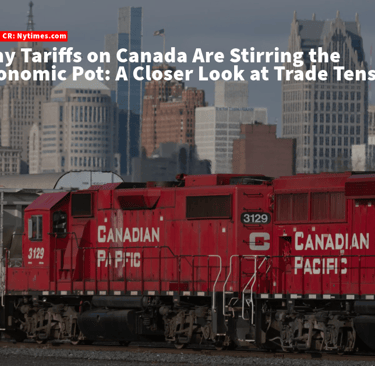Why Tariffs on Canada Are Stirring the Economic Pot: A Closer Look at Trade Tensions
4/17/2025


Why Tariffs on Canada Are Stirring the Economic Pot: A Closer Look at Trade Tensions
Picture this: two neighbors, sharing the world’s longest undefended border, sipping maple syrup and coffee together for decades. Now, imagine one slapping a tax on the other’s goods, sparking a heated economic showdown. That’s the scene unfolding between the United States and Canada, where tariffs are shaking up trade and raising eyebrows. But why are these tariffs happening, and what do they mean for the future of North American relations? Let’s dive into the drama, unpack the reasons, and explore the ripple effects in this high-stakes trade tango.
The Heart of the Tariff Tussle
At its core, the U.S. imposition of tariffs on Canada is a mix of economic strategy, political posturing, and old-fashioned trade disputes. The U.S. argues that Canada’s practices—particularly in industries like softwood lumber and dairy—give its producers an unfair edge. For years, the U.S. has claimed that Canadian lumber, a staple in homebuilding, is subsidized by provincial governments, flooding the American market with cheap wood. The response? Tariffs to level the playing field, making Canadian lumber pricier and boosting U.S. producers.
Then there’s the dairy dilemma. Canada’s tightly controlled dairy sector, shielded by high tariffs on U.S. imports, has long frustrated American farmers. These protective measures ensure Canadian dairy stays dominant at home, but they’ve fueled U.S. demands for reciprocity. Tariffs, in this case, are a jab in a broader trade negotiation, pushing Canada to open its markets.
But it’s not just about lumber and cheese. National security has entered the chat. The U.S. has slapped tariffs on Canadian steel and aluminum, citing concerns about over-reliance on foreign metals. More recently, rhetoric around border security—think drug trafficking and immigration—has been floated as a justification for broader tariffs. It’s a bold move, raising questions about whether these measures are truly about security or simply economic leverage.
The Bigger Picture: Economic Goals and Political Games
Beyond specific disputes, tariffs on Canada reflect broader U.S. economic ambitions. Reducing the trade deficit is a big one. By making Canadian goods more expensive, the U.S. hopes to nudge consumers toward American-made products, boosting local manufacturing and jobs. It’s part of a push to “reshore” industries, bringing production back to U.S. soil after decades of globalization.
Tariffs also serve as a negotiating hammer. Think of them as a high-stakes poker chip in trade talks, like those surrounding the U.S.-Mexico-Canada Agreement (USMCA). By flexing economic muscle, the U.S. aims to extract concessions, whether it’s opening Canada’s dairy market or addressing other trade imbalances. But this strategy isn’t without risks—it’s a tightrope walk that could strain a historically friendly relationship.
The Ripple Effects: Who Pays the Price?
Here’s where things get messy. Tariffs don’t just affect boardrooms; they hit wallets. Higher prices on Canadian goods—like lumber for home construction or dairy in your grocery cart—can pinch consumers. U.S. businesses reliant on Canadian imports face higher costs, which could lead to layoffs or price hikes. And Canada isn’t sitting idly by. Retaliatory tariffs from Ottawa target U.S. exports, from whiskey to machinery, creating a tit-for-tat cycle that could hurt industries on both sides.
The economic fallout extends beyond dollars and cents. Canada and the U.S. share one of the world’s most integrated supply chains—think auto parts crisscrossing the border. Tariffs threaten to gum up this well-oiled machine, potentially disrupting production and raising costs for manufacturers. For border communities, where trade is a way of life, the stakes are personal.
A Delicate Dance of Diplomacy
So, why escalate tensions with a close ally? Some see tariffs as a blunt tool to rally domestic support, signaling a tough stance on trade. Others view them as a genuine attempt to protect American workers. Critics, however, warn that the collateral damage—higher prices, strained alliances, and economic uncertainty—might outweigh the benefits. Canada, after all, isn’t just a trading partner; it’s a strategic ally in everything from defense to energy.
The path forward hinges on diplomacy. Can the U.S. and Canada find common ground, perhaps through tweaks to the USMCA or bilateral agreements? Or will tariffs deepen the divide, pushing Canada to seek new trade partners elsewhere? The answers will shape not just economies but the very fabric of North American cooperation.
What’s Next?
As the tariff saga unfolds, it’s clear this isn’t just about lumber, dairy, or steel—it’s about the future of trade, trust, and shared prosperity. The U.S. and Canada have weathered storms before, but navigating this one will require finesse, compromise, and a clear-eyed view of what’s at stake.
Thought-Provoking Questions:
Are tariffs on Canada a smart move to protect U.S. jobs, or do they risk harming consumers and businesses more than they help?
How can the U.S. and Canada balance fair trade with their deep economic ties?
Could these tariffs push Canada to diversify its trade partnerships, reducing reliance on the U.S.?
hello@boncopia.com
+13286036419
© 2025. All rights reserved.